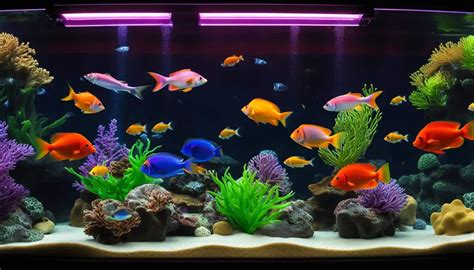1. The State of Aquarium Lighting
Aquarium lighting has come a long way since the days of incandescent bulbs. Today, there are a wide variety of options available, each with its own unique benefits and drawbacks.

Incandescent bulbs are the least efficient type of aquarium lighting, and they produce a lot of heat. This can be a problem in smaller aquariums, where the water temperature can easily rise to dangerous levels.
Fluorescent bulbs are more efficient than incandescent bulbs, and they produce less heat. However, they can be more expensive, and they have a shorter lifespan.
LED bulbs are the most efficient type of aquarium lighting, and they produce the least heat. They are also more durable than other types of bulbs, and they have a longer lifespan.
2. The Benefits of LED Aquarium Lighting
LED aquarium lighting offers a number of benefits over other types of lighting. These benefits include:
- Energy efficiency: LED bulbs use up to 75% less energy than incandescent bulbs. This can save you money on your energy bills.
- Heat reduction: LED bulbs produce very little heat, which can help to keep your aquarium water temperature stable.
- Long lifespan: LED bulbs have a lifespan of up to 50,000 hours, which is much longer than other types of bulbs.
- Durability: LED bulbs are very durable, and they can withstand being dropped or bumped.
3. The Future of Aquarium Lighting
The future of aquarium lighting is bright. LED technology is still evolving, and new innovations are being made all the time. In the next few years, we can expect to see even more efficient, longer-lasting, and more affordable LED aquarium lights.
Here are a few of the trends that we can expect to see in the future of aquarium lighting:
- Increased use of LEDs: LED bulbs will continue to replace other types of bulbs in aquarium lighting applications.
- Development of new LED technologies: New LED technologies will make LED aquarium lights even more efficient and affordable.
- Integration of smart technology: LED aquarium lights will become more integrated with smart technology, allowing you to control your lights from your smartphone or tablet.
4. How to Choose the Right Aquarium Light
When choosing an aquarium light, there are a few things to consider:
- The size of your aquarium: The size of your aquarium will determine the wattage of the light you need.
- The type of fish you have: Different types of fish have different lighting needs. For example, saltwater fish need more light than freshwater fish.
- The plants you have: If you have live plants in your aquarium, you will need to choose a light that provides the right amount of light for plant growth.
5. Tips for Using Aquarium Lighting
Here are a few tips for using aquarium lighting:
- Use a timer to turn your lights on and off: This will help to regulate your fish’s sleep cycle and prevent algae growth.
- Adjust the intensity of your lights: The intensity of your lights should be appropriate for the type of fish and plants you have in your aquarium.
- Clean your lights regularly: Dirty lights can reduce the amount of light that reaches your fish and plants.
6. FAQs
1. What is the best type of aquarium light?
LED aquarium lights are the best type of aquarium light because they are energy-efficient, produce very little heat, have a long lifespan, and are durable.
2. How many watts of light do I need for my aquarium?
The wattage of the light you need for your aquarium will depend on the size of your aquarium and the type of fish and plants you have. A good rule of thumb is to use 1 watt of light per gallon of water.
3. How long should I leave my aquarium lights on?
The length of time you should leave your aquarium lights on will depend on the type of fish and plants you have. A good rule of thumb is to leave your lights on for 10-12 hours per day.
4. Can I use a regular light bulb in my aquarium?
No, you should not use a regular light bulb in your aquarium. Regular light bulbs produce too much heat and can damage your fish and plants.
7. Case Detail
Case Detail 1:
Aquarist A used a 50-watt incandescent bulb in his 20-gallon aquarium. The bulb produced too much heat, and the water temperature rose to dangerous levels. The fish in the aquarium became stressed and died.
Case Detail 2:
Aquarist B used a 20-watt LED bulb in his 20-gallon aquarium. The bulb produced very little heat, and the water temperature remained stable. The fish in the aquarium were healthy and active.
8. Market Insights
The global aquarium lighting market size was valued at $2.5 billion in 2020, and it is projected to reach $4.5 billion by 2028, exhibiting a CAGR of 7.5% during the forecast period.
The growth of the market is attributed to the increasing popularity of aquariums as a hobby and the rising demand for energy-efficient lighting solutions.
9. Conclusion
Aquarium lighting is an important part of any aquarium setup. The right light can help to keep your fish and plants healthy and happy. LED aquarium lights are the best type of aquarium light because they are energy-efficient, produce very little heat, have a long lifespan, and are durable.





















